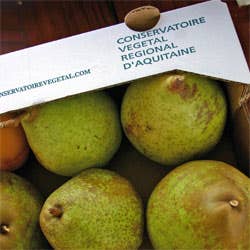
A Day for Apples and Saints
What do a third-century virgin martyr and 2,000 heritage fruit trees have in common? In the corner of southwestern France where I live, they are celebrated on November 25 with a special gastronomic gardening fete.
"À la Sainte Catherine, tout bois prend racine." That's the French dicton, or proverb, that declares that on Saint Catherine's feast day, November 25, all trees, shrubs, and cuttings take root. In gardener's terms, this means that now is the time to plant bare-root fruit trees. What perfect timing! Not only am I a "Catherine", but my saint's name day falls just four days before my birthday: a double chance to plan a "green" birthday present for myself and add a few more trees to the heirloom orchard I've been planting next to the kitchen garden of my canalside home, Camont.
Just a few kilometers down the canal at Montesquieu is the Conservatoire Vegetal Regional d'Aquitaine (Regional Plant Conservatory of Aquitaine), locally referred to as the Orchard Museum. This weekend, in honor of Saint Catherine's feast day, Evelyne Leterme, the director and passionate founder of the CVRA, will host the annual Fete des Arbres, a tree festival that welcomes over 5,000 visitors who taste, buy, and plant the native and heirloom fruit and nut trees that are grown in the fertile Garonne River valley. Since 1990, more than 150,000 heritage fruit trees have been sold.
Earlier this fall, Mme Leterme (who also wrote the definitive book on heritage fruit trees, Les Fruits Retrouves) walked me around the orchard. Tempting fruit dropped to the ground like so much confetti littering a summer-long party. Although apples are the undisputed king here, 15 other species crowded the 20-acre site—in total, over 2,000 different varieties of fig, peach, hazelnut, apricot, quince, pomegranate, and plum (including the famous prune d'ente for those delicious pruneaux d'agen).
At the Orchard Museum, tradition and aesthetics determine how various trees and vines are planted together. A series of alternating orchard rows with planted crops like wheat and corn is referred to as a joualle; hedgerows of hazelnuts, plums, and figs create an enclos, or enclosure,__ around a small pasture; and strips of land are planted with riotous pink cosmos and orange zinnias to let the soil rest and attract the hardworking bee and butterfly population.
This weekend—November 24-25, 2007—the public is invited to Leterme's grande fete to taste and buy. If "an apple a day keeps the doctor away", this will be the healthiest place in Gascony. You'll find me there, elbowing my way to the tasting stands of fruit juice and confitures before ordering the nursery stock and loading up and driving a few grafted scions of Pomme d'Anis or Poire Citron off the lot. Then, while most Americans are recovering from Thanksgiving feasts and shopping-mall overload, I'll be digging holes and planting a Court Pendu Rouge de Lot et Garonne, a juicy and sweet native apple, and a Poire Saint-Jean, an early pear variety that celebrates yet another saint, John.
_(Kate Hill lives in an 85 foot Dutch barge on what she calls her "long village": the canals and rivers of France. You can read more about her French kitchen adventures and canalside cooking school on her award winning blog at www.katehill.blogspot.com.)___
Keep Reading
Continue to Next Story










